Odisha State Board CHSE Odisha Class 11 Math Solutions Chapter 6 Complex Numbers and Quadratic Equations Ex 6(b) Textbook Exercise Questions and Answers.
CHSE Odisha Class 11 Math Solutions Chapter 6 Complex Numbers and Quadratic Equations Exercise 6(b)
Question 1.
If Z1 and Z2 are two complex numbers then show that
\(\begin{aligned}
& \left|1-z_1 \overline{z_2}\right|^2-\left|z_1-z_2\right|^2 \\
& =\left(1-\left|z_1\right|^2\right)\left(1-\left|z_2\right|^2\right)
\end{aligned}\)
Solution:
Let z1 and z2 be two complex numbers.
Let z1 = a + ib, z2 = c + id
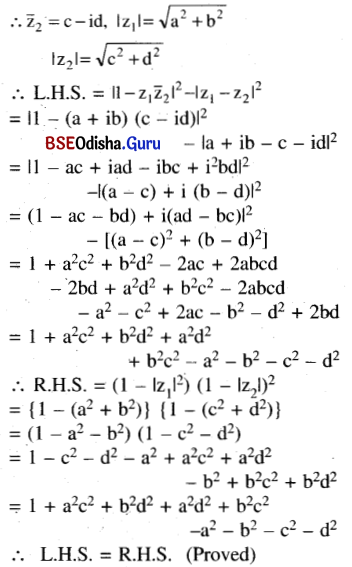
Question 2.
If a, b, c are complex numbers satisfying a + b + c = 0 and a2 + b2 + c2 = 0 then show that |a| = |b| = |c|
Solution:
Let a + b + c = 0 and a2 + b2 + c2 = 0
Then (a + b + c)2 = 0
⇒ a2 + b2 + c2 + 2ab + 2bc + 2ca = 0
⇒ 2(ab + bc + ca) = 0
⇒ ab + bc = – ca
⇒ b(a + c) = – ca
⇒ b(- b) = – ca [a + b + c = 0]
⇒ b2 = ca
⇒ b3 = abc
Similarly it can be shown that a3 = abc and c3 = abc
Thus a3 = b3 = c3
⇒ |a3|= |b3| = |c3|
⇒ |a|3 = |b|3 = |c|3
⇒ |a| = |b| = |c|
![]()
Question 3.
What do the following represent?
(i) { z : |z – a| + |z + a| = 2c } where |a| < c
Solution:
{ z : |z – a| + |z + a| = 2c } where |a| < c …….(1)
Here z is a complex number.
Let z = x + iy.
∴ (x, y) is the point corresponding to the complex number z?
Let ‘a’ and ‘ – a’ be two fixed points.
∴ Eqn. (1) implies that the sum of the distances of the point (x, y) from two points la and a’ is constant i.e. 2c
∴ The locus is an ellipse.
(ii) {z : |z – a| – |z + a| = c }
Solution:
Here {z : |z – a| – |z + a| = c } implies that, the difference of the distances of the point (x, y) from two fixed points ‘ – a’ and ‘a’ is a constant i.e. c.
So the locus is a hyperbola.
(iii) What happens in (i) |a| > c?
Solution:
In(i), if |a| > c. then there is no locus. But if |a| = c, then the locus reduces to a straight line.
Question 4.
Given cos α + cos β + cos γ = sin α + sin β + sin γ = 0 Show that cos 3α + cos 3β + cos 3γ = 3 cos (α + β + γ)
Solution:
Let a = cos α + i sin α,
b = cos β + i sin β
c = cos γ + i sin γ
∴ a + b + c = ( cos α + cos β + cos γ) + i ( sin α + sin β + sin γ)
= 0 + i0 = 0
∴ a3 + b3 + c3 – 3 abc
= (a + b + c )( a2 + b2 + c2 – ab – bc – ca) = 0
or, a3 + b3 + c3 = 3 abc
or, ( cos α + i sin α)3 + (cos β + i sin β)3 + ( cos γ + i sin γ)3
= 3( cos α + i sin α) (cos β + i sin β) ( cos γ + i sin γ)
or, cos 3α + i sin 3α + cos 3β + i sin 3β + cos 3γ + i sin 3γ
= 3[cos (α + β + γ) + i sin (α + β + γ)]
or, (cos 3α + cos 3β + cos 3γ) + i (sin 3α + sin 3β + sin 3γ)
= 3 cos (α + β + γ) + i 3 sin (a + β + γ)
∴ cos 3α + cos 3β + cos 3γ
= 3 cos (α + β + γ) and sin 3α + sin 3β + sin 3γ
= 3 sin (α + β + γ)
Question 5.
Binomial theorem for complex numbers. Show that (a+b)n = an nC1an-1b + …..+ ncran-rbr + …..+ bn where a,b ∈ C and n, rule of multiplication of complex numbers and the relation nCr + nCr-1 = n+1Cr)
Solution:
Let a and b be two complex numbers
Let a = α1 + iβ1, b = α2 + iβ2
(a + b)1 = (α1 + iβ1 + α2 + iβ2)1
= α1 + iβ1 + α2 + iβ2
= (α1 + iβ1)1 + 1C1(α1 + iβ1)1-1(α1 + iβ1)1
= a1 + 1C1 a1-1 b1
∴ P1 is true
Let Pk be true
i.e., (a + b)k = ak + kC1 ak-1 b1 + … + bk
where a.b ∈ C
Now ( a + b)k+1 = (a + b)k (a + b)1
= (ak + kC1 ak-1b1 +…+ bk) (a + b)
= ak-1 + bak+ kC1 akb + kC1ak-1b2 + … + bk+1
= ak+1 + akb(kC1+ 1)+ …+ bk+1
= ak+1 + k+1C1akb1 + k+1 C2ak-1b2 +… + bk+1
∴ Pk+1 is true
∴ Pn is true for all values of n ∈ N
Question 6.
Use the Binomial theorem and De Moiver’s theorem to show
cos 3θ = 4 cos 3 θ – 3 cos θ,
sin 3θ = 3 sin θ – 4 sin 3 θ
Express cos nθ as a sum of the product of powers of sin θ and cos θ. Do the same thing for sin nθ.
Solution:
We have (cos θ + i sin θ)3
= cos 3θ + i sin 3θ …..(1)
But by applying the Binomial theorem, we have
(cos θ + i sin θ)3
= cos 3 θ + 3C1 (cos θ)3-1 (i sin θ)1 + 3C2 (cos θ)3-2 (i sin θ)2 + (i sin θ)3
= cos3θ + 3i cos2θ sin θ + 3i2 cos θ sin2 θ + i3 sin3 θ
= (cos3 θ – 3 cos θ sin2 θ) + i(3 cos2 θ sin θ – sin3 θ)
∴ cos 3 θ =cos3 θ – 3 cos θ(1 – cos2 θ)
= cos3 θ – 3 cos θ + 3 cos 3 θ
= 4 cos3 θ – 3 cos θ and
sin 3θ = 3 cos2 θ sin3 θ – sin3 θ
= 3 (1 – sin2 θ) sin θ – sin3 θ
= 3 sin θ – 3 sin3 θ – sin3 θ
= 3 sin θ – 4 sin3 θ (Proved)
Again, (cos θ + i sin θ)n
= cos nθ + i sin nθ ….(3)
Also, (cos θ + i sin θ)n
= cosn θ + nC1 cosn-1 θ ( i sin θ) + nc2 cos n-2 θ (i sin θ)2 + …+ (i sin θ)
= cosn θ – nC2 cosn-2 θ sin2 θ + nC4 cosn-4 θ sin4 θ – …) + i (nC1 cosn-1 θ sin θ – nC3 cosn-3 θ sin 3 θ) + nC5 cosn-5 θ sin5 θ – …) …..(4)
Equating real part and imaginary parts in (1) and (3), we have
cos nθ = cosn θ – nC2 cosn-2 θ × sin2 θ + nC4 cosn-4 θ sin4 θ …
and sin nθ = nC1 cosn-1 θ sin θ – nC3 cosn-3 θ sin3 θ + nC5 cosn-5 θ sin5 θ…
Question 7.
Find the square root of
(i) – 5 + 12 √-1
Solution:
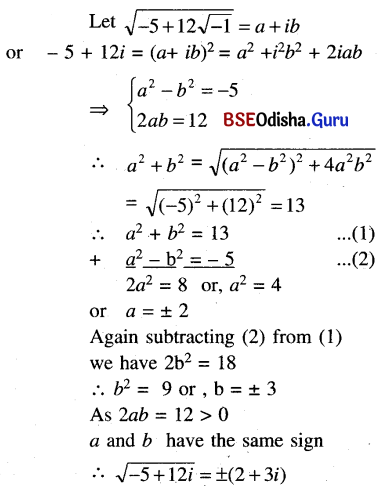
(ii) – 11 – 60 √-1
Solution:
Let \(\sqrt{-11-60 \sqrt{-1}}\) = x + iy
Squaring both sides we get
– 11 – 60i = (x + iy)2
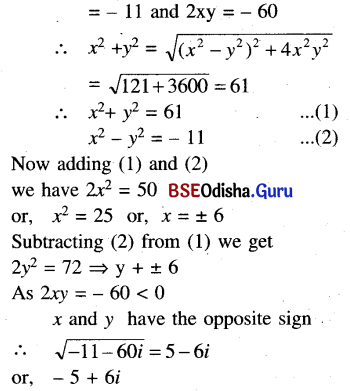
(iii) – 47 + 8 √-1
Solution:
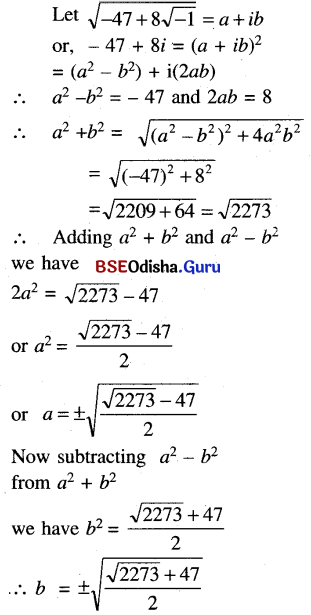
As 2ab = 8 > 0, a and b have the same sign.
∴ \(\sqrt{-47+8 i}\)
\(=\pm\left(\sqrt{\frac{\sqrt{2273}-47}{2}}+i \frac{\sqrt{2273}+47}{2}\right)\)
(iv) – 8 + √-1
Solution:
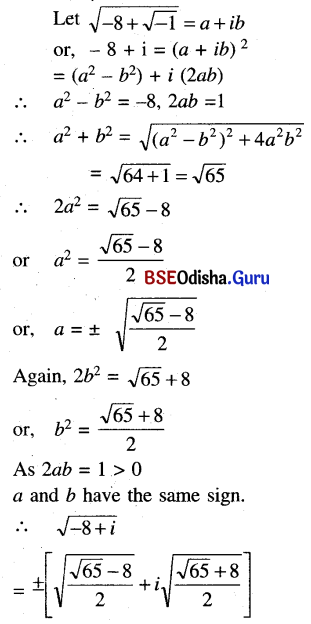
(v) a2 – 1 +2a √-1
Solution:
a2 – 1 + 2a √-1
= a2 + i2 + 2ai = (a + i)2
∴ \(\sqrt{a^2-1+2 a \sqrt{-1}}\) = ±(a + i)
(vi) 4ab – 2 (a2 – b2) √-1
Solution:
4ab – 2 (a2 – b2) √-1
= (a + b)2 – (a – b)2 – 2(a2 – b2)i
= (a + b)2 + (a – b)2i2 – 2(a + b)(a – b)i
= (a + b) – i(a – b)2
∴ \(\sqrt{4 a b-2\left(a^2-b^2\right) \sqrt{-1}}\)
= ±[(a + b) – i (a – b)]
![]()
Question 8.
Find the values of cos72° ….
Solution:
Let 18° = θ then 5θ = 90°
⇒ 3θ = 9θ – 2θ
⇒ cos 3θ = cos (9θ – 2θ) = sin 2θ
⇒ 4 cos3 θ – 3 cos θ = 2 sin θ cos θ
⇒ 4 cos2 0 – 3 = 2 sin 0 (∴ cos θ = cos 18° ≠ 0)
⇒ 4(1 – sin2 θ) – 3 = 2 sin θ
⇒ 4 sin2 θ + 2 sin θ – 1 = 0
⇒ sin θ = \(\frac{-2 \pm \sqrt{4+16}}{2 \times 4}=\frac{-1 \pm \sqrt{5}}{4}\)
⇒ sin 18° = \(\frac{-1+\sqrt{5}}{4}=\frac{\sqrt{5}-1}{4}\)
(∴ 18° is a cut)
Now cos 72° = cos (90° – 18°)
= sin 18° = \(\frac{\sqrt{5}-1}{4}\)
For other methods refer 148 pages of the text book.
Question 9.
Find the value of cos 36°.
Solution:
We have 36° = \(\frac{\pi^0}{5}\)
∴ cos 36° = cos \(\frac{\pi}{5}\)
Let α = cos \(\frac{\pi}{5}\) + i sin \(\frac{\pi}{5}\)
be the root of the equation x5 + 1 = 0
Again, if x5 + 1 = 0
or, x5 = – 1 = cosπ + i sinπ
or, x = (cos π + i sin π )1/5
= [cos (π + 2kπ)+ i sin (π + 2kπ)]1/5
or, x = cos \(\frac{(2 k+1) \pi}{5}+i \sin \frac{(2 k+1) \pi}{5}\)
where 2kπ is the period of sine and cosine and k = 0, 1, 2, 3, 4
∴ The eqn x5 + 1 = 0 has 5 roots out of which -1 is one root which corresponds to k = 2
Again,
x5 + 1 = (x + 1)(x4 – x3 + x2 – x + 1)
So their 4 roots will be obtained on solving the eqn.
x4 – x3 + x2 – x + 1 = 0
we have, x4 – x3 + x2 – x + 1 = 0
or, x2 – x + 1 – \(\frac{1}{x}+\frac{1}{x^2}\) = 0
(Dividing both sides by x2)

Re α i.e. cos \(\frac{\pi}{5}=\frac{1+\sqrt{5}}{5}=\frac{\sqrt{5}+1}{4}\)
and cos.108° = \(\frac{1-\sqrt{5}}{4}\)
Question 10.
Evaluate cos \(\frac{2 \pi}{17}\) using the equation x17 – 1 = 0
Solution:
x17 – 1 = 0
or, x17 = 1 = cos 0° + i sin 0°
= cos (0 + 2kπ) + i sin (0 + 2kπ)
= cos 2kπ + i sin 2kπ
or x = (cos 2kπ + i sin 2kπ)1/17
= cos \(\frac{2k \pi}{17}\) + i sin \(\frac{2k \pi}{17}\)
If k = 1, x = cos \(\frac{2 \pi}{17}\) + i sin \(\frac{2 \pi}{17}\)
If k = 0 , x = 1
As x17 – 1 = (x – 1) (x16 + x15 + …. +1)
So one root of the eqn. x17 – 1 = 0 is 1 and all other roots are the roots of the eqn.
x16 + x15 + ….+ 1 = 0
∴ The value of cos \(\frac{2 \pi}{17}\) can be found from the roots of the eqn. (1)
Question 11.
Solve the equations.
(i) z7 = 1
Solution:
z7 = 1 = cos 0 + i sin 0
= cos (0 + 2kπ) + i sin (0 + 2kπ)
= cos 2kπ + i sin 2kπ
∴ z = (cos 2kπ + i sin 2kπ)1/7
= cos \(\frac{2k \pi}{7}\) + i sin \(\frac{2k \pi}{7}\)
where k = 0, 1, 2, 3, 4, 5, 6
(ii) z3 = i
Solution:


(iii) z6 = – i
Solution:
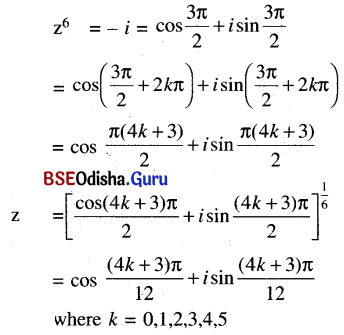
(iv) z3 = 1 + i
Solution:
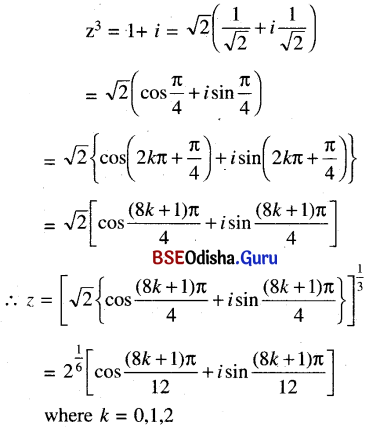
Question 12.
If sin α + sin β + cos γ = 0
= cos α + cos β + cos γ = 0
Show that
(i) sin 3α + sin 3β + sin 3γ = 3 sin (α + β + γ)
Solution:
Refer to Q. No. 4
(ii) sin2 α + sin2 β + sin2 γ = cos2 α + cos2 β + cos2 γ =3/2
Solution:
Let x = cos α + i sin α,
y = cos β + i sin β
z = cos β + sin β
∴ x + y + z = (cos α + cos β + cos γ) + i ( sin α + sin β + sin γ) = 0 +i0= 0
∴ xy + yz + zx = xyz (\(\frac{1}{x}+\frac{1}{y}+\frac{1}{z}\)) = 0
Since \(\frac{1}{x}+\frac{1}{y}+\frac{1}{z}\) = cos α – i sin α + cos β – i sin β + cos γ – i sin γ
= (cos α + cos β + cos γ) – i (sin α + sin β + sin γ) = 0 – i0 =0
∴ (x + y + z)2 = x 2 + y2 +z2 + 2(xy + yz + zx)
= x2 + y2 + z2 + 0 = x2 + x2 + z2
or 0 = x2 + y2 + z2
∴ x2 +y2 + z2 =0
or, (cos α + i sin α)2 + (cos β + i sin β)2 + ( cos γ + i sin γ)2 = 0
or, cos 2α + i sin 2α + cos 2β + i sin 2β + cos 2γ + i sin 2γ = 0
or, (cos 2α + cos 2β + cos 2γ) + i(sin 2α + sin 2β + sin 2γ) = 0
∴ cos 2α + cos 2β + cos 2γ = 0
or, cos2 α – sin2 α + cos2 β – sin2 β + cos2 γ – sin2 γ =0
or, (cos2 α + cos2 β + cos2 γ) = (sin2 α + sin2 β + sin2 γ)
But cos2 α + sin2 α + cos2 β + sin2 β + cos2 γ + sin2 γ = 1 + 1 + 1 = 3
∴ cos2 α + cos2 β + cos2 γ = sin2 α + sin2 β + sin2 γ = 3/2 (Proved)
![]()
Question 13.
If x + \(\frac{1}{x}\) = 2 cos θ
Show that \(x^n+\frac{1}{x^n}\) = 2 cos nθ
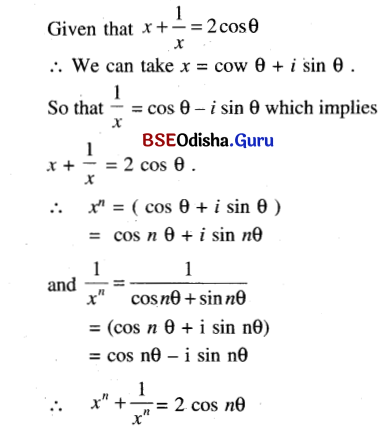
Question 14.
xr = cos ar + i sin ar
r =1, 2, 3 and x1 + x2 + x3 = 0 Show that \(\frac{1}{x_1}+\frac{1}{x_2}+\frac{1}{x_3}\) = 0
Solution:
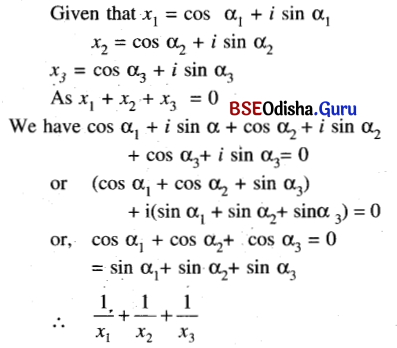
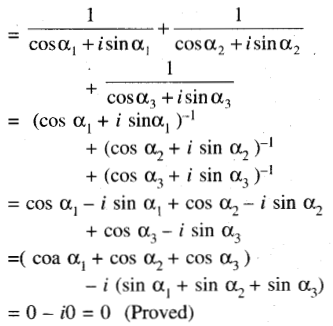
Question 15.
Show that \(\left(\frac{1+\sin \theta+i \cos \theta}{1+\sin \theta-i \cos \theta}\right)^n\) = \(\cos \left(\frac{n \pi}{2}-n \theta\right)+i \sin \left(\frac{n \pi}{2}-n \theta\right)\)
Solution:
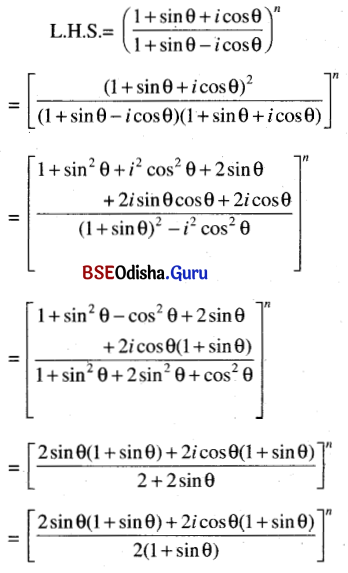
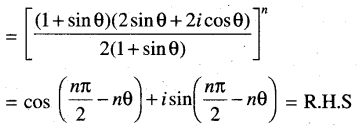
Question 16.
If α and β are roots x2 – 2x + 4 = 0 then show that \(\alpha^n+\beta^n=2^{n+1} \cos \frac{n \pi}{3}\)
Solution:
we have x2 – 2x + 4 = 0
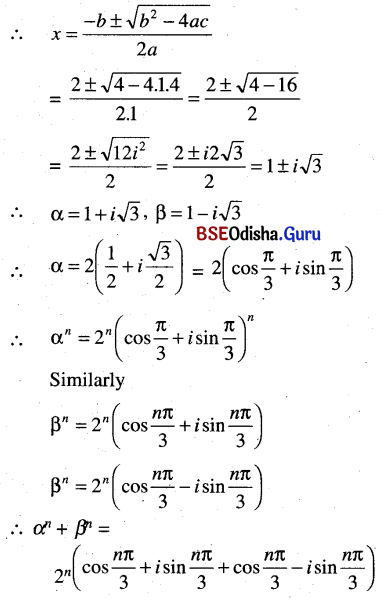
= \(2^n \times 2 \cos \frac{n \pi}{3}=2^{n+1} \cos \frac{n \pi}{3}\)
Question 17.
For a positive integer n show that
(i) (1 + i)n + (1 – i)n = \(2^{\frac{n+2}{2}} \cos \frac{n \pi}{4}\)
Solution:
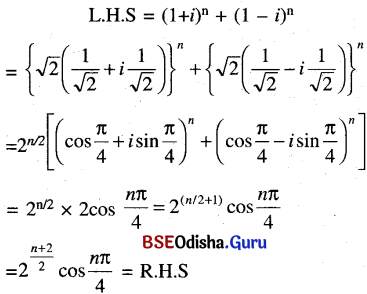
(ii) (1 + i√3)n + (1 – i√3)n = \(2^{n+1} \cos \frac{n \pi}{3}\)
Solution:

Question 18.
Let x + \(\frac{1}{x}\) = 2 cos α, y + \(\frac{1}{y}\) = 2 cos β, z + \(\frac{1}{z}\) = 2 cos γ. Show that
(i) 2 cos (α + β + γ) = xyz + \(\frac{1}{xyz}\)
Solution:
We can take x = cos α + i sin α
y = cos β + i sin β, z = cos γ + i sin γ
∴ xyz = (cos α + i sin α ) (cos β + i sin β ) (cos γ + i sin γ)
= cos (α + β + γ) – i sin (α + β + γ)
∴ \(\frac{1}{xyz}\) = cos (α + β + γ) – i sin(α + β + γ)
∴ xyz + \(\frac{1}{xyz}\) = 2 cos(α + β + γ)
(ii) 2 cos (pα + qβ + rγ) = \(x^p y^q z^r+\frac{1}{x^p y^q z^r}\)
Solution:
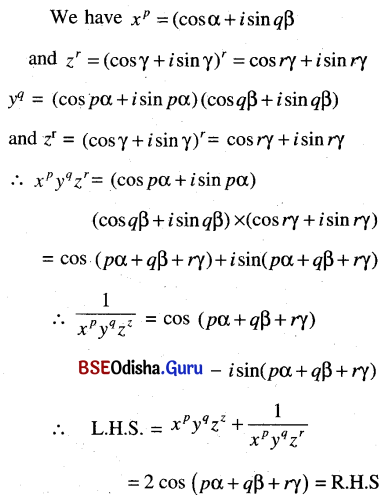
Question 19.
Solve x9 + x5 – x4 = 1
Solution:
x9 + x5 – x4 = 1
or, x5(x4 + 1) – (x4 + 1) = 0
or, (x5 – 1) (x4 + 1) = 0
x4 + 1 = 0 and x5 – 1 = 0
x4 = – 1 = cos π + i sin π
= cos (π + 2nπ) + i sin (π + 2nπ)
∴ x = [cos (2n + 1) π + 1 sin (2n + 1) π]1/4
= \(\cos \frac{2 n+1 \pi}{4}+i \sin \frac{2 n+1 \pi}{4}\)
for n = 0, 1, 2, 3
Again, x5 – 1 = 0 or, x5 = 1
or, x5 = cos 0 + i sin 0
= cos 2nπ + i sin 2nπ
or, x = (cos 2nπ + i sin 2nπ)1/5
= \(\cos \frac{2 n \pi}{5}+i \sin \frac{2 n \pi}{5}\)
Where n = 0, 1, 2, 3, 4.
![]()
Question 20.
Find the general value of θ if (cos θ + i sin θ) (cos 2θ + i sin 2θ),…..(cos nθ + i sin nθ) =1
Solution:

Question 21.
If z = x + iy show that |x| + |y| ≤ √2 |z|
Solution:
z = x + iy
∴ |z| = \(\sqrt{x^2+y^2}\)
∴ |z| = x2 + y2
We have (|x| – |y|)2 ≥ 0
⇒ |x|2 + |y|2 -2|x||y|> 0
⇒ 2(|x|2 + |y|2) – 2|x||y| ≥ |x|2 + |y|2
⇒ 2(|x|2 + |y|2) ≥ |x|2 + |y|2 + 2|x||y|
⇒ 2|z|2 ≥ (|x| + |y|)2
⇒ √2|z| ≥ |x| + |y|
⇒ |x| + |y| ≤ √2|z|
Question 22.
Show that
Re (Z1Z2) = Re z1, Re z2 – Im z1, Im z2
Im (Z1Z2) = Re z1, Im z2 + Re z2 Im z1
Solution:
Let z1 = a + ib, z2 = c + id
∴ z1, z2 = (a + ib) (c + id)
= ac + iad + ibc + i2bc
= (ac – bd) + i (ad + be)
∴ Re (z1, z2) = ac – bd – Re z1. Re z2
– Im z1,. Im z2
Again, Im z1, z2 = ad + be
= Re z1. Im z2 + Im z1,. Re z2
Question 23.
What is the value of arg ω + arg ω2?
Solution:
arg ω = arg ω2 = arg (ω • ω2)
= arg (ω3) = arg (1) = 2nπ
∴ The principal agrument = 0.
Question 24.
If |z1| ≤ 1, |z2| ≤ 1 show that \(\left|1-z_1 \overline{z_2}\right|^2-\left|z_1-z_2\right|^2=\left(1-\left|z_1\right|^2\right)\left(1-\left|z_2\right|^2\right)\) Hence and otherwise show that. \(\left|\frac{z_1-z_2}{1-z_1 z_2}\right|<1 \text { if }\left|z_1\right|<1,\left|z_2\right|<1\)
Solution:

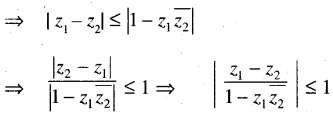
Question 25.
If z12 + z22 + z32 – z1z2 – z2z3 – z3z4 = 0 Show that |z1 – z2| = |z2 – z3| = |z3 – z1|
Solution:
Let z12 + z22 + z32 – z1z2 – z2z3 – z3z4 = 0
⇒ 2z12 + 2z22 + 2z32 – 2z1z2 – 2z2z3 – 2z3z4 = 0
⇒ (z1 – z2)2 + (z2 – z3)2 + (z3 – z1)2 = 0
Put a = z1 – z2, b = z2 – z3, c = z3 – z1
Then a + b + c = 0 and a2 + b2 + c2 = 0 As in Q2 we can show that |a| = |b| = |c|
⇒ |z1 – z2| = |z2 – z3| = |z3 – z1|
Question 26.
If |a| < |c| show that there are complex numbers z satisfying |z – a| = |z + a| = 2|c|
Solution:
Let z = x + iy
∴ |z – a| + |z + a| = 2c
or, |x + iy – a| + |x + iy + a| = 2c
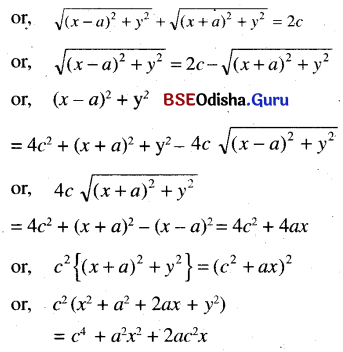

Question 27.
Solve \(\frac{(1-i) x+3 i}{2+i}+\frac{(3+2 i) y+i}{2-i}=-i\) where x, y, ∈ R.
Solution:
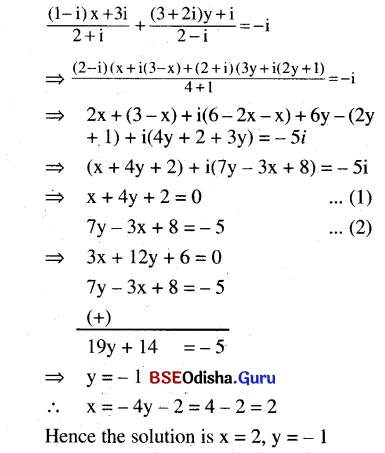
Question 28.
If (1 + x + x2)n = p0 + p1x + p2x2 + …..+ p2nx2n, then prove that p0 + p3 + p6 + …..+ 3n-1
Solution:
Given, (1 + x + x2)n = p0 + p1x + p2x2 + …..+ p2nx2n
putting x = ω we get
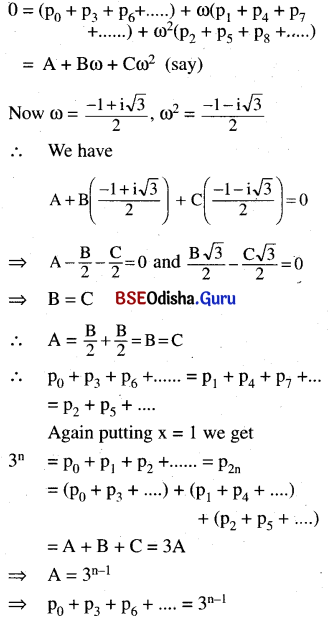
![]()
Question 29.
Find the region on the Argand plane on which z satisfying
[Hint Arg (x + iy) =\(\frac{\pi}{2}\) = 0, y>0]
(i) 1 < |z – 2i| < 3
Solution:
Let z = x + iy
The given inequality is
1 < |x + i(y – 2)| < 3
⇒ \(1<\sqrt{x^2+(y-2)^2}<3\)
(ii) arg \(\left(\frac{z}{z+i}\right)=\frac{\pi}{2}\)
Solution:

As all are +ve we have
1 < x2 + (y – 2)2 < 9
x2 + (y – 2)2 < 9 is the region inside the circle with center (0, 2) and radius 1.
x2 + (y – 2)2 > 1 is the region outside the circle with center (0, 2) and radius.
∴ 1 < |z – 2i| < 3 is the region between two concentric circles with center (0, 2) and radius 1 and 3 which is shows below.

